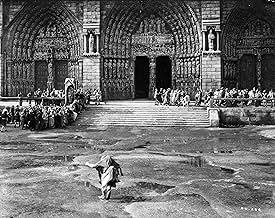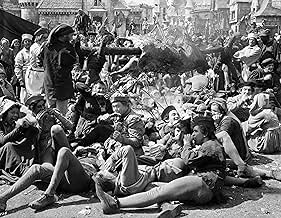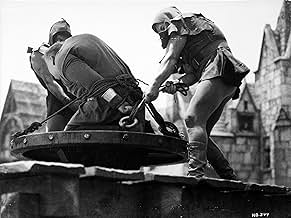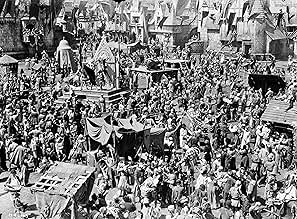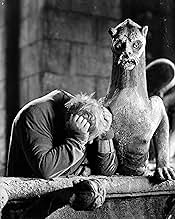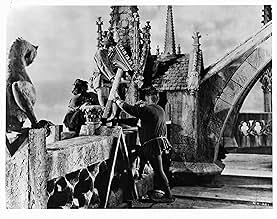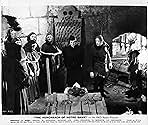El jorobado de Nuestra Señora de París
Título original: The Hunchback of Notre Dame
CALIFICACIÓN DE IMDb
7.8/10
13 k
TU CALIFICACIÓN
En la París del siglo XV, una chica gitana es incriminada en un asesinato por un juez que la desea, y solo el campanero de la ciudad puede salvarla.En la París del siglo XV, una chica gitana es incriminada en un asesinato por un juez que la desea, y solo el campanero de la ciudad puede salvarla.En la París del siglo XV, una chica gitana es incriminada en un asesinato por un juez que la desea, y solo el campanero de la ciudad puede salvarla.
- Dirección
- Guionistas
- Elenco
- Nominado a 2 premios Óscar
- 1 premio ganado y 2 nominaciones en total
Cedric Hardwicke
- Frollo
- (as Sir Cedric Hardwicke)
Helene Reynolds
- Fleur de Lys
- (as Helene Whitney)
Minna Gombell
- Queen of Beggars
- (as Mina Gombell)
Rod La Rocque
- Phillippe
- (as Rod LaRocque)
- Dirección
- Guionistas
- Todo el elenco y el equipo
- Producción, taquilla y más en IMDbPro
Opiniones destacadas
One of the great Hollywood films of 1939, this adaptation of Victor Hugo's novel is sumptuously put together, boasting a fine script, tight direction by German export William Dieterle, and a cast who fit their parts perfectly: Charles Laughton superb as the maligned Quasimodo; Maureen O'Hara in an early role as gypsy Esmeralda; Cedric Hardwicke as the pious Frollo; and Harry Davenport as the king, Louis XI.
The story is a version of Beauty and the Beast set within the confines of Notre Dame Cathedral and the dirt-strewn and prejudiced streets of Paris. Quasimodo, physically repulsive and deafened by the bells of the cathedral, nevertheless finds it in his childish heart to love the beautiful Esmeralda and to sacrifice his sanctuary for her. She however only has eyes for the dashing Gringoire (Edmond O'Brien) who she saves from the justice of the beggar thieves.
It is Laughton's performance that holds this film together - truly one of the greatest screen actors, capable of portraying pathos like no other. Contrast this film role with his Henry VIII or Captain Bligh and you begin to get an idea of his impressive range.
The story is a version of Beauty and the Beast set within the confines of Notre Dame Cathedral and the dirt-strewn and prejudiced streets of Paris. Quasimodo, physically repulsive and deafened by the bells of the cathedral, nevertheless finds it in his childish heart to love the beautiful Esmeralda and to sacrifice his sanctuary for her. She however only has eyes for the dashing Gringoire (Edmond O'Brien) who she saves from the justice of the beggar thieves.
It is Laughton's performance that holds this film together - truly one of the greatest screen actors, capable of portraying pathos like no other. Contrast this film role with his Henry VIII or Captain Bligh and you begin to get an idea of his impressive range.
The 1939 version of Hugo's classic tale of beauty and the beast is definitely the definitive. It features a great performance by Charles Laughton as Quasimodo, dubbed the Hunchback of Notre Dame, because of his twisted appearance. It's pointless for me to talk about the story, because I'm sure everyone is familiar with it, it's one of the best works of literature ever produced. Id' just like to say this is a beautiful film about a beautiful person, cursed to be considered an out cast, "the king of fools"... Films like this and David Lynch's The Elephant Man really make you think a little differently about this so-called "beautiful" world. The Hunchback of Notre Dame has something for everyone to enjoy.
Losy in the monatge of 1939 films ...somewhat is a film I believe is more enriching and florid than " Gone With The Wind" and possibly just as romantic as " Wuthering Heights"
Laughton's performance is one of the most astonishing put on film ever. A Stellar cast is in place from O' Hara to O' Brien..What can I say , Thomas Mitchell who probably graced more films than any other actor is superb.
Hugo,s timeless classic is brought to life in black and white and with sets that make you feel ..you are there.
The great Cedric Hardwicke potrays the tormented one and for sure ..its 116 minutes of pure film making ..and it all takes place on fools day....
CP
Laughton's performance is one of the most astonishing put on film ever. A Stellar cast is in place from O' Hara to O' Brien..What can I say , Thomas Mitchell who probably graced more films than any other actor is superb.
Hugo,s timeless classic is brought to life in black and white and with sets that make you feel ..you are there.
The great Cedric Hardwicke potrays the tormented one and for sure ..its 116 minutes of pure film making ..and it all takes place on fools day....
CP
10llltdesq
The best of the many versions of The Hunchback of Notre Dame, for my money, is this one, although Lon Chaney's is a close second. Despite a Hollywood tendancy to change the novel's ending so as not to depress the cash customers (although, pray tell, if you're going to change the ending, why does no one ever see Quasimodo sailing off to Tahiti with the girl? Rule # 1: strong, handsome poets beat out disfigured cripples every time, even if they're heroes. This is more true in real life than in the movies. Take my word for this, I know from painful experience *sigh*)
Charles Laughton is exceptional and Maureen O'Hara would make any man swoon and is perfect for the part of Esmerelda. The support includes the usual suspects-Thomas Mitchell, Harry Davenport and many other familiar character actors. Strike up the band and start the parade. Thunderous applause. Most highly recommended.
Charles Laughton is exceptional and Maureen O'Hara would make any man swoon and is perfect for the part of Esmerelda. The support includes the usual suspects-Thomas Mitchell, Harry Davenport and many other familiar character actors. Strike up the band and start the parade. Thunderous applause. Most highly recommended.
Charles Laughton's boisterous portrayal of Quasimodo and Maureen O'Hara's charm as Esmerelda are two of the things that make this version of "The Hunchback of Notre Dame" a fine production that still works very well. Most of the versions of the story have been at least watchable, because the Victor Hugo novel provides so much good material to work with, much of it well-suited for cinema. This adaptation, though, is one of the best at making good use of what it offers.
It's interesting to compare this picture with the 1923 Lon Chaney version - not for the sake of ranking them, since both are fully worthy of attention in their own right, but because they offer somewhat different strengths, and because they emphasize somewhat different aspects of the story.
Chaney and Laughton are both quite effective as Quasimodo, each giving an interpretation of the character that corresponds to the actor's skills. Laughton brings out Quasimodo's feelings and perspective quite well. In this version, for example, the flogging scene is longer and more detailed, and it is one of Laughton's most effective scenes. Chaney is particularly good at reacting to the other characters and their actions. Both give the character a distinctive and memorable look.
O'Hara is also one of this adaptation's strengths. Patsy Ruth Miller was good in the Chaney version, but O'Hara has the advantage of spoken dialogue, and she makes the character of Esmerelda her own.
While the Chaney version especially emphasized the atmosphere, this one has quite a bit of action. The tumultuous climactic sequences are done quite well, and they leave a vivid impression. Overall, this is a very satisfying adaptation of the fine classic novel.
It's interesting to compare this picture with the 1923 Lon Chaney version - not for the sake of ranking them, since both are fully worthy of attention in their own right, but because they offer somewhat different strengths, and because they emphasize somewhat different aspects of the story.
Chaney and Laughton are both quite effective as Quasimodo, each giving an interpretation of the character that corresponds to the actor's skills. Laughton brings out Quasimodo's feelings and perspective quite well. In this version, for example, the flogging scene is longer and more detailed, and it is one of Laughton's most effective scenes. Chaney is particularly good at reacting to the other characters and their actions. Both give the character a distinctive and memorable look.
O'Hara is also one of this adaptation's strengths. Patsy Ruth Miller was good in the Chaney version, but O'Hara has the advantage of spoken dialogue, and she makes the character of Esmerelda her own.
While the Chaney version especially emphasized the atmosphere, this one has quite a bit of action. The tumultuous climactic sequences are done quite well, and they leave a vivid impression. Overall, this is a very satisfying adaptation of the fine classic novel.
¿Sabías que…?
- TriviaFor the scene in which Quasimodo is whipped, Charles Laughton instructed an assistant director to twist his ankle outside of camera range so he would really be in pain. Even through the heavy hump and rubber body suit, he felt every lash and often came home badly bruised. Before the 16th take, director William Dieterle whispered to him, "Now, Charles, listen to me. Let's do it one more time, but this time I want you . . . I want you to suffer." According to Laughton's wife, Elsa Lanchester, the actor never forgave him for that.
- ErroresThe cathedral is shown as having a full flight of steps up to the front doors. Notre Dame has always been more or less level with the square (le Parvis).
- Citas
[Last lines]
Quasimodo, the bell-ringer: [to one of the stone gargoyles] Why was I not made of stone - like thee?
- Créditos curiososPROLOGUE: "With the end of the 15th Century, the Middle Ages came to a close. Europe began to see great changes. France, ravaged by a hundred years of war, at last found peace. The people under Louis XI felt free to hope again --- to dream of progress. But superstition and prejudice often stood in the way, seeking to crush the adventurous spirit of man."
- Versiones alternativasAlso available in a computer colorized version.
- ConexionesEdited into The Clock (2010)
- Bandas sonorasAve Maria
(1572) (uncredited)
Music by Tomás Luis de Victoria
Sung by mixed chorus during opening credits
Selecciones populares
Inicia sesión para calificar y agrega a la lista de videos para obtener recomendaciones personalizadas
Detalles
- Fecha de lanzamiento
- País de origen
- Sitio oficial
- Idioma
- También se conoce como
- The Hunchback of Notre Dame
- Locaciones de filmación
- Productora
- Ver más créditos de la compañía en IMDbPro
Taquilla
- Presupuesto
- USD 1,800,000 (estimado)
- Tiempo de ejecución1 hora 56 minutos
- Color
- Relación de aspecto
- 1.37 : 1
Contribuir a esta página
Sugiere una edición o agrega el contenido que falta

Principales brechas de datos
By what name was El jorobado de Nuestra Señora de París (1939) officially released in India in English?
Responda

